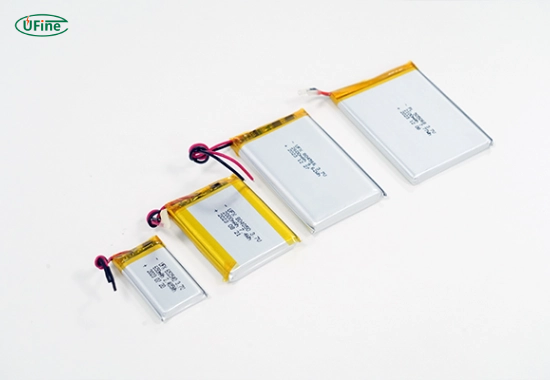
- Part 1. What is a flat lithium battery and how is it different from standard batteries?
- Part 2. Why is flat lithium battery thickness critical in slim device design?
- Part 3. What thickness is considered ultra-thin for flat lithium batteries?
- Part 4. What materials and technologies make flat lithium batteries ultra-thin?
- Part 5. What are typical discharge rates for ultra-thin flat lithium batteries?
- Part 6. Applications of ultra-thin flat lithium batteries in modern electronics
- Part 7. Pros and cons of using ultra-thin lithium batteries
- Part 8. How to select the ideal thickness for a flat lithium battery
- Part 9. Safety considerations when using ultra-thin flat lithium batteries
- Part 10. Future trends in ultra-thin lithium battery technology
- Part 11. FAQs related to flat lithium battery thickness and ultra-thin design
Flat lithium battery technology is revolutionizing the way we power today’s ultra-slim electronic devices. But what exactly qualifies as an ultra-thin battery in this fast-evolving industry?
An ultra-thin, flat lithium battery is generally defined as one that measures between 0.5 mm and 2.0 mm in thickness, depending on the application’s power demands and space constraints.
In this in-depth guide, we’ll delve into the technical aspects of these batteries, examine how thickness affects performance, and outline the discharge rates you can expect. If you’re designing next-generation wearables, medical devices, or IoT sensors, this article will help you select the optimal battery profile for your specific needs.
Part 1. What is a flat lithium battery and how is it different from standard batteries?
A flat lithium battery is a type of rechargeable lithium-ion or lithium-polymer battery designed in a flat, compact shape, usually as a pouch cell. Unlike cylindrical or prismatic cells, flat lithium batteries are engineered to fit within the tight internal spaces of modern electronic products.
The flat design makes them ideal for applications that require low-profile energy sources, such as:
- Smartwatches
- Hearing aids
- Smart cards
- Medical implants
- Thin mobile devices
- Fitness trackers
The key difference lies in the form factor and flexibility. Flat lithium batteries use sealed, laminated packaging that allows for custom thickness, while maintaining a high energy-to-volume ratio.
Part 2. Why is flat lithium battery thickness critical in slim device design?
When it comes to designing compact electronics, battery thickness is one of the most critical dimensions.
A few important reasons why thickness matters include:
- Physical fit: If the battery is too thick, it simply won’t fit into the device.
- Battery capacity vs. size: Thicker batteries often provide more capacity, but at the cost of size.
- Thermal management: Thinner batteries may have limited surface area for heat dissipation.
- Weight reduction: Thinner equals lighter, which is crucial for wearables and portable devices.
In ultra-slim devices like smart rings or biometric patches, a sub-1mm battery could be the difference between success and failure in design.
Part 3. What thickness is considered ultra-thin for flat lithium batteries?
Flat lithium batteries are considered ultra-thin when their thickness ranges from 0.5mm to 2.0mm.
The definition may vary slightly by industry, but here’s a general classification:
| Thickness Range | Classification |
|---|---|
| 0.5mm – 2.0mm | Ultra-thin |
| 2.1mm – 4.0mm | Thin |
| 4.1mm – 6.0mm | Medium thickness |
| 6.1mm and above | Standard or thick |
Ultra-thin batteries are typically custom-built for high-value applications where space efficiency is as important as power delivery.
Part 4. What materials and technologies make flat lithium batteries ultra-thin?
The thinness of flat lithium batteries is made possible through advanced materials and manufacturing processes.
Key materials include:
- Lithium Cobalt Oxide (LiCoO₂) or Lithium Nickel Manganese Cobalt (NMC) for the cathode
- Graphite or lithium titanate for the anode
- Polymer electrolytes or gel electrolytes that allow a flexible structure
- Micron-level separators to maintain safety while minimizing thickness
- Aluminum-laminated pouches as lightweight and compressible casings
Key technologies used:
- Roll-to-roll coating to apply electrode materials in ultra-thin layers
- Laser cutting and vacuum lamination for precise layering
- Dry electrode coating to reduce component thickness without sacrificing energy density
- Solid-state battery research for next-gen ultra-thin designs
Together, these innovations allow manufacturers to produce batteries as thin as 0.4mm, without compromising on safety, cycle life, or energy performance.
Part 5. What are typical discharge rates for ultra-thin flat lithium batteries?
Discharge rate, measured in C-rate, determines how quickly a battery delivers power. Ultra-thin flat lithium batteries generally have moderate discharge rates, optimized for low-power devices.
Most ultra-thin lithium batteries have a discharge rate between 0.2C and 1C.
Here’s what that means:
- 0.2C: Battery discharges in 5 hours (ideal for passive sensors)
- 0.5C: Battery discharges in 2 hours (common in wearables)
- 1C: Full discharge in 1 hour (used in more active devices)
High-drain devices may require custom chemistry or thicker cells to maintain safety and avoid overheating.
Part 6. Applications of ultra-thin flat lithium batteries in modern electronics
Ultra-thin flat lithium batteries are found in:
- Wearables such as smartwatches, rings, and fitness bands
- Medical devices, including insulin pumps and heart monitors
- Smart cards and RFID tags
- IoT modules and wireless sensors
- Flexible displays and e-paper devices
- Hearing aids and audio implants
- Smart clothing and textiles
These applications demand long runtime, lightweight structure, and safe operation in a tiny footprint.
Part 7. Pros and cons of using ultra-thin lithium batteries
Here are the key advantages of ultra-thin flat lithium batteries:
- Compact and lightweight
- Customizable shapes and sizes
- High energy density per volume
- Ideal for slim and flexible electronics
- Reliable rechargeability
However, there are challenges as well:
- Lower absolute capacity due to size
- Higher cost per mAh
- Complex design requirements
- Delicate handling and protection needed
Understanding these trade-offs helps engineers make the right design decisions for their products.
Part 8. How to select the ideal thickness for a flat lithium battery
Choosing the right battery thickness involves balancing multiple factors:
- Device housing space: Measure exact available dimensions.
- Power requirements: Calculate mAh needed for desired runtime.
- Discharge profile: Consider how fast the device consumes energy.
- Thermal profile: Thinner batteries must be kept within safe temperature limits.
- Flexibility: Will the device bend or flex during use?
For example, a smart patch for skin monitoring might use a 0.9mm battery, while a portable ECG device might allow a 2.5mm cell for longer battery life.
Part 9. Safety considerations when using ultra-thin flat lithium batteries
Safety is a top concern with all lithium batteries, especially ultra-thin designs that lack rigid protection.
Key safety elements include:
- Built-in protection circuits to prevent overcharging or short circuits
- Reinforced pouch materials to resist puncture
- Smart battery management systems (BMS)
- Proper enclosure design in the device to avoid stress on the battery
Also, it’s crucial to follow manufacturer testing guidelines and certification standards like CE, UL, or IEC.
Part 10. Future trends in ultra-thin lithium battery technology
The future of flat lithium battery thickness is heading toward even thinner, safer, and smarter solutions. Some future trends include:
- Solid-state thin batteries with no liquid electrolyte for higher safety
- Printed lithium batteries using ink-based electrodes for flexible electronics
- Graphene-enhanced electrodes for ultra-high conductivity in thin profiles
- Stackable thin cell modules to increase capacity without thickness
- Bio-integrated batteries for direct use in living tissues or wearable patches
Some cutting-edge prototypes are already achieving thicknesses as low as 0.3mm, opening up possibilities in smart wearables, soft robotics, and implantable electronics.
Part 11. FAQs related to flat lithium battery thickness and ultra-thin design
What is the thinnest type of rechargeable flat lithium battery available today?
The thinnest rechargeable flat lithium batteries available today are around 0.3mm to 0.5mm thick, using solid-state or polymer technologies. These are custom-designed and used in ultra-compact medical or wearable devices.
How does battery thickness impact the lifespan of a flat lithium battery?
Thinner batteries typically have a lower cycle count and capacity, which may reduce lifespan in high-drain applications. However, with proper charge management and low-power design, ultra-thin batteries can last 300 to 1000 cycles.
Can ultra-thin flat lithium batteries be used in flexible or bendable devices?
Yes. Many flat lithium batteries are made with flexible polymer layers instead of rigid casings. This allows them to be used in bendable electronics, smart textiles, and curved displays, provided the bending radius is within limits defined by the manufacturer.
Are there specific certifications required for ultra-thin battery products?
Yes. Devices using ultra-thin lithium batteries should comply with UN38.3, UL1642, IEC62133, and other safety standards depending on region and application. Certification ensures safe transport, usage, and disposal.
What are the best use cases for ultra-thin lithium batteries under 1mm?
Flat lithium batteries under 1mm are best used in smart cards, biometric patches, hearing aids, and disposable medical devices. These applications require low capacity, low discharge current, and minimal thickness.
Related Tags:
More Articles

Best Group 34 Battery Guide: AGM, Lithium & Lead-Acid Options
Discover Group 34 battery dimensions, capacity, CCA ratings, and the best AGM or lithium options. Learn which Group Size 34 battery fits your car.
Understanding 5V Batteries: From Basics to Choosing the Right Charger
Discover everything about 5V batteries, from types and capacities to applications and charging options. Learn how to make the best choice for your power needs.
Discover how many amps a 9V battery can supply, its actual current output, discharge rate, and capacity for alkaline, lithium, and rechargeable 9V batteries.
How Long Can a 3.7V Lithium-Ion Cell Last?
Discover how long a 3.7V lithium ion cell lasts! Learn factors impacting battery life, plus tips to extend its use. Get the most from your devices now.
Is an 8 Volt Golf Cart Battery Right for You? Golf Cart Battery Comparison
Not sure if an 8 volt golf cart battery is right for you? This guide explains the benefits, costs, types, and top brands to help you choose the best battery.



